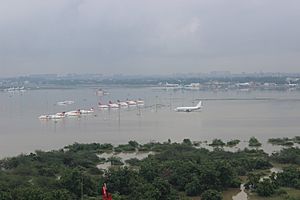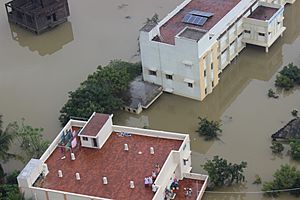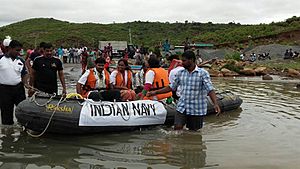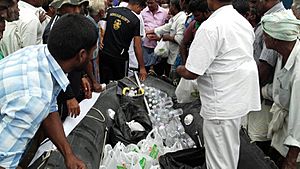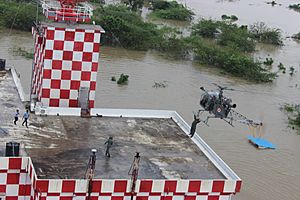2015 South India floods facts for kids
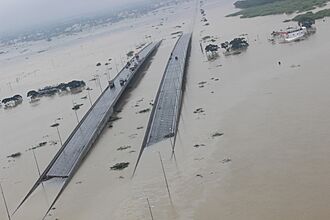
Submerged bridges in Chennai
|
|
| Date | 8 November 2015 – 14 December 2015 |
|---|---|
| Location | South India (Tamil Nadu, Puducherry, Andhra Pradesh) |
| Deaths | 500+ Tamil Nadu: 422 (official, likely more) Andhra Pradesh: 81 Puducherry: 3 |
| Property damage | ₹199 billion (US$3 billion) – over ₹1,000 billion (US$17 billion) (unofficial estimates) Tamil Nadu: ₹14,602 crore-₹50,000+ crore (US$2.2 billion-US$7.5+ billion, unofficial estimates) Andhra Pradesh: ₹4,960 crore (US$843 million) Pondicherry: ₹333 crore (US$57 million) |
The 2015 South India floods happened because of very heavy rain. This rain came from the yearly northeast monsoon in November and December 2015. The floods hit the Coromandel Coast in the southern Indian states of Tamil Nadu and Andhra Pradesh.
More than 500 people died, and over 1.8 million people had to leave their homes. The damage and losses were huge, costing from about 200 billion Indian Rupees to over 1 trillion Indian Rupees. This made the 2015 South India floods the most expensive floods that year. They were also among the costliest natural disasters of 2015.
Even though the heavy rain was linked to a weather event called El Niño, a government report in 2018 said the floods in Tamil Nadu were a "man-made disaster." This report blamed the Government of Tamil Nadu for how bad the disaster became. The government had called it a natural disaster.
Understanding the Floods
Why Did So Much Rain Fall?
Every year from October to December, a large part of South India gets a lot of rain. This rain comes from the northeast monsoon, also known as the winter monsoon. Places like Tamil Nadu, coastal Andhra Pradesh, and Puducherry get up to 60% of their yearly rain during this time.
The northeast monsoon happens as the regular monsoon rains move away from northeastern India. The rain during this monsoon can be very heavy. Sometimes, it brings much more rain than the regular monsoon. This extra rain can get even worse during an El Niño event, like the one in 2015.
Areas Prone to Flooding
Coastal areas of Andhra Pradesh often get the worst of the heavy rains. Puducherry and eastern Tamil Nadu also flood easily because they have many rivers and wetlands. The city of Chennai, for example, had five big floods between 1943 and 2005. The floods in 1943, 1978, and 2005 caused a lot of damage.
Sadly, new buildings have been put up where wetlands and natural water areas used to be. This, along with old city pipes and bad drainage systems, has made severe flooding happen more often.
How the Weather Systems Formed
On November 8, 2015, during the yearly Cyclone season, a low-pressure area formed. It grew stronger and became a deep depression. It then moved across the coast of Tamil Nadu near Puducherry the next day.
This weather system brought very heavy rain to the coastal and northern parts of Tamil Nadu. On November 13, Kanchipuram got 340 mm of rain. Many low-lying areas were flooded. On November 15, another low-pressure area moved north along the coast. It dropped huge amounts of rain over coastal Tamil Nadu and Andhra Pradesh. Some places got 370 mm of rain in 24 hours. Chennai International Airport recorded 266 mm of rain in one day.
Later, from November 28–29, another system developed. It reached Tamil Nadu on November 30, bringing even more rain and flooding. On December 1, Tambaram received 490 mm of rain in 24 hours. This caused massive flooding all along the coast from Chennai to Cuddalore. A study showed that clouds stayed over Chennai on December 1. This was because the Eastern Ghats mountains blocked the clouds from moving inland. This caused continuous rain and huge floods in Chennai.
Floods in Tamil Nadu
Chennai City Floods
Between November 9 and 10, 2015, Neyveli received 483 mm of rain. Heavy rains also hit Cuddalore, Chidambaram, Tiruvallur, Kanchipuram, and Chennai. Many low-lying areas in Kanchipuram were flooded. For example, Gandhi Road was underwater after a lake overflowed.
Over 1,000 people had to leave their homes in Chennai by November 13. Years of illegal building and not being ready for floods made the situation worse in Chennai. Much of the city was still flooded on November 17. Chennai received 1,049 mm of rain in November. This was the most since November 1918. The flooding in Chennai was called the "worst in a century." Schools and colleges in Puducherry and nearby districts stayed closed. Fishermen were warned not to go out to sea.
More heavy rains came on December 1. Many parts of Chennai were flooded again. Power was cut to 60% of the city. Several hospitals stopped working. The Chief Minister of Tamil Nadu, Jayalalithaa, announced that school exams would be moved to January. For the first time since 1878, the newspaper The Hindu did not print a paper on December 2. This was because workers could not reach the building. Major train services were canceled, and Chennai International Airport closed until December 6.
Chennai was officially declared a disaster area on December 2. At one hospital, 14 patients died when power and oxygen failed. Floodwaters slowly went down in Chennai by December 4. But 40% of the city was still underwater. There was not enough safe food and drinking water. Relief efforts began, but North Chennai did not get much help. Thousands of people had to leave on their own.
By December 6, rescue efforts were mostly done. Relief efforts became stronger. Mobile, banking, and power services slowly came back. Fuel and food supplies reached people. The airport fully reopened, and trains slowly started running again. But many areas were still flooded. Some places did not have basic needs because relief supplies were not given out well. Health officials watched for diseases that spread in water. They warned that conditions were right for outbreaks.
Officials said at least 57,000 homes in Chennai were damaged. Schools and colleges in the affected areas reopened on December 14. Relief work mostly ended by December 19.
Floods in Other Tamil Nadu Districts
South of Chennai, heavy rains and floods continued into December. In Kancheepuram district, areas like Chengalpattu and Tambaram were flooded up to 7 meters deep. Roads were washed away, and train links were cut. 98 people in the district died.
Parts of Villupuram and Tiruvarur districts got up to 10 centimeters of rain. Some towns in Cuddalore district saw up to nine centimeters. Flood warnings were sent to villages near the Tirumurthy dam in Tirupur district. Dams in Tirunelveli district were full, so water had to be released. This caused the Thamirabarani River to flood. Heavy rains also flooded thousands of acres of rice fields in Thanjavur, Tiruvarur, and Nagapattinam districts. Houses collapsed in Kumbakonam.
Cuddalore district was also very badly hit. Six of its 13 areas were heavily damaged in November. More heavy rain from December 1 flooded Cuddalore again. Tens of thousands of people had to leave their homes. Even with rescue teams and supplies, many people did not get basic items. This led to some relief trucks being stopped and looted. Thousands of residents were stuck by floodwaters. Over 60,000 hectares of farmland were flooded. More than 30,000 people went to relief camps.
The state government said the floods caused about 84.81 billion Indian Rupees in damage. They asked for 20 billion Indian Rupees for immediate help. An insurance company called Aon Benfield said these floods were the costliest in 2015. They were also the eighth costliest natural disaster of the year.
By January 2016, the government said 421 people in Tamil Nadu died from the floods. But relief workers and police reported many more missing or dead. Morgues and cemeteries in Chennai were very busy. Over 3 million families had their homes damaged. About 38,276 hectares of crops were lost. This included rice and other farm crops. About 98,000 farm animals and chickens died.
Puducherry Floods
Puducherry had less damage in November. Some trees fell, and banana and sugarcane farms were badly hurt. Puducherry got 55.7 mm of rain in one day. Water entered homes in low areas, and three houses fell down. Many roads were flooded and damaged.
The Chief Minister, N Rangasamy, said officials were ready for floods. Schools and colleges in Puducherry and Karaikal districts closed on November 16. By November 24, over 4,800 hectares of farmland were flooded. The government asked for 1.82 billion Indian Rupees for relief.
On December 1, Puducherry had received 83.4 centimeters of rain in November alone. This was more than the usual amount for the whole monsoon season. The government asked for another 1 billion Indian Rupees for immediate help. By December 4, the government said it would ask for a total of 3.33 billion Indian Rupees for flood relief.
From December 1, very heavy rains hit Puducherry again. It recorded 22 cm of rain in 24 hours. This was the wettest December day ever. The District Collector said the rain was "unprecedented." 618 houses were damaged, and over 2,000 people were moved to safe places. In Karaikal, nearly 50 houses were damaged.
By December 5, almost 9,000 hectares of rice fields were damaged. Other crops like sugarcane, plantains, and vegetables were also hurt. The government planned to pay money to farmers for their lost crops. For example, 20,000 Indian Rupees per hectare for rice fields.
Three people died in Puducherry because of the floods. One man died when a mud wall fell on November 9. Another man died from the rain. A woman died on November 17 when a rain-weakened mud wall collapsed.
Andhra Pradesh Floods
The heavy rain started in Andhra Pradesh on November 9. Nellore and Chittoor districts were hit. Tirumala got 309 mm of rain, causing floods in Chittoor District. Schools in Nellore district closed on November 16. The temple town of Tirupathi got about 27 cm of rain. Thousands of lakes and ponds overflowed. The Swarnamukhi River rose. Three people were swept away by floodwaters in Chittoor district. Roads were damaged, stopping transport.
Heavy rain in Nellore, Chittoor, and Kadapa districts flooded villages. Over 500 km of roads were damaged by November 18. The Chennai–Kolkata highway was damaged, trapping hundreds of vehicles. Over 10,000 truck drivers were stuck on a highway in Nellore district. Officials set up 61 relief camps. About 500 water tanks broke as rivers overflowed.
In Kadapa district, the rains stopped by November 18. About 290 million Indian Rupees worth of farm losses were estimated. Other farm losses were reported in Rayalaseema, Nellore, and other districts.
On November 19, Chief Minister Chandrababu Naidu told Prime Minister Narendra Modi that flood damage was about 12.5 billion Indian Rupees for farms and 10.25 billion Indian Rupees for buildings. He asked for 10 billion Indian Rupees for immediate help. Nellore district was the most affected, with 13.95 billion Indian Rupees in losses. Chittoor district lost 8.18 billion Indian Rupees. The fish and prawn farming industry in Nellore district was badly hit, losing 2.5 billion Indian Rupees.
Heavy rains started again on December 2. Chittoor district received 50 to 160 mm of rain. Chief Minister Naidu told officials to clean water and set up medical camps. By December 4, the Home Minister said there were heavy losses in Nellore and Chittoor districts. Over 500,000 acres of crops were destroyed. The state asked for 37.5 billion Indian Rupees for immediate help. By December 12, the total damage from the floods was estimated at 49.6 billion Indian Rupees.
As of December 4, 81 people had died in Andhra Pradesh. Over 14,000 people were moved to relief camps.
Impact of the Floods
Effect on Daily Life
Getting basic things like milk, water, and vegetables became very hard. During the December floods in Chennai, milk packets sold for 100 Indian Rupees, which was five times their normal price. Water bottles sold for 100 to 150 Indian Rupees. Vegetables were also much more expensive.
Fuel supplies and travel were also badly affected, especially in Chennai. Airfares to and from South India became almost 10 times higher than usual. A trip from Mumbai to Bangalore, which usually cost 10,000 to 20,000 Indian Rupees, went up to 100,000 Indian Rupees. The Ministry of Civil Aviation warned airlines not to overcharge. They also ran special flights from a naval airbase at a fixed low price.
Economic Losses
In Chennai, over 150,000 street vendors lost more than 3 billion Indian Rupees. Many big car makers like Ford, Renault, Nissan, and Daimler AG had to stop making cars. This led to estimated losses of up to 10 billion Indian Rupees. Experts thought total industry losses were between 10 billion and 150 billion Indian Rupees. Many big technology companies also closed their offices. Their employees worked from home or from other cities.
Prices of vegetables and fruits went up a lot. This was because over 50% of supplies were affected. The Indian Oil Corporation had to close its large refinery in Chennai. Popular TV channels also stopped working due to technical problems. Motorcycle maker Royal Enfield closed its Chennai offices and plants. They lost the production of 4,000 motorcycles in November. The Chennai real estate market lost almost 300 billion Indian Rupees. Over 20,000 small and medium factories in Tamil Nadu lost over 140 billion Indian Rupees.
Insurance companies in India expected to pay out over 10 billion Indian Rupees for damaged property and goods. By late January 2016, they had received about 50,000 claims totaling 48 billion Indian Rupees.
Big Indian IT companies like Tata Consultancy Services and Wipro said the floods would affect their earnings. Car makers also had lower production. German car maker BMW expected to start making cars again only in January 2016. American car maker Ford started its plant in late December 2015. BMW's production loss was about 2.5 billion Indian Rupees, and Ford's was about 6 billion Indian Rupees.
Helping Those Affected
Relief Efforts in Tamil Nadu
Tamil Nadu Chief Minister Jayalalithaa announced 5 billion Indian Rupees for relief and rehousing. Families who lost relatives would get 400,000 Indian Rupees. Twelve cyclone shelters were built. Eleven teams from the National Disaster Response Force (NDRF) were sent to Tamil Nadu. Over 10,000 people were rescued by November 27. Many relief camps were set up. The Indian Air Force used helicopters to rescue people from flooded parts of Chennai.
Political parties asked for quick action and money from the central government. The opposition party, Dravida Munnetra Kazhagam (DMK), gave 10 million Indian Rupees to the state government. But their leader, Karunanidhi, said the 5 billion Indian Rupees given by the government was not enough. He asked for more federal money and suggested getting funds from rich people in Tamil Nadu.
The Indian Coast Guard and the three branches of the Indian Armed Forces helped with rescues. The Indian Army and Air Force rescued people in Kancheepuram district. The Air Force flew 25 missions, dropping 5,000 kg of supplies and rescuing 25 people. Power was restored in most villages in Cuddalore district. Medical camps and animal shelters were set up. Over 90,000 food packets were given out.
By November 18, 55,000 people in Tamil Nadu were checked for water-borne diseases. The central government gave 9.396 billion Indian Rupees for immediate relief. They gave another 10 billion Indian Rupees on December 3. Over 1.1 million people were rescued in the Chennai area.
When floods returned on November 30, Prime Minister of India Narendra Modi promised all possible help. The NDRF, Coast Guard, and armed forces continued rescuing people. In Chennai, 80 relief centers were set up for 10,845 people. The police used drones to find over 200 people, who were all rescued. By December 2, the NDRF had 22 rescue teams and saved over 500 people. By December 3, the NDRF had rescued over 5,000 people.
The Indian Navy also helped a lot. They sent a ship, the INS Airavat, with divers and boats. Three naval flood relief teams were sent with food packets. A naval air station, INS Rajali, became a temporary airport for supplies and evacuations. Other navy ships brought more divers, tents, blankets, food, and water. General Dalbir Singh Suhag, the head of the Army, flew to Chennai to check on rescue efforts.
By December 5, over 1.1 million people had been moved to safe places. Thousands more were in relief camps. People started draining stagnant water. Thousands of volunteers and individuals helped with food, water, clothes, and medicines. Medical teams and camps were set up to help the sick.
The Union Minister of Telecommunications, Ravi Shankar Prasad, said BSNL would give free phone services for a week. The National Crisis Management Committee sent milk, water, biscuits, and noodles. They also sent more army troops. In Madurai district, officials gave money to 412 people whose houses were damaged. Coimbatore City Corporation sent 500,000 Indian Rupees worth of relief supplies to Chennai.
By December 10, the Tamil Nadu government said 1.716 million people were in 6,605 relief camps. 600 boats were used. Over 12 million food packets were given out. 26,270 medical camps were held, treating 2.565 million people. Over 80,000 people from different official groups helped with rescues. The Chennai Corporation received 1.3 million relief items. Over 100,000 tonnes of flood debris were cleared. Relief operations in Chennai mostly ended by December 19.
On December 5, Prime Minister Modi announced payments of 200,000 Indian Rupees to families of those who died. Those seriously injured would get 50,000 Indian Rupees. On December 7, the Tamil Nadu government announced a full relief plan. People who lost huts would get a new house, 10,000 Indian Rupees, rice, a sari, and a dhoti. Those in damaged houses would get clothes, rice, and 5,000 Indian Rupees. New houses would be built for 10,000 families.
Money for relief would be put into bank accounts. Aid like rice and clothes would be given out at public stores. The Chief Minister ordered a count of affected families. For those who lost homes along rivers, 10,000 new homes were given. Lost farm animals would also be paid for. For example, 10,000 Indian Rupees for cows and buffaloes. Farmers who lost crops would get money too. Special camps would be held to give out new copies of important documents like land deeds and school certificates for free.
The Chief Minister also asked Prime Minister Modi for a loan program to help families buy new belongings. By February 2016, the Chief Minister's Public Relief Fund received 3.39 billion Indian Rupees in donations.
Relief Efforts in Andhra Pradesh
In Andhra Pradesh, the state government gave 500,000 Indian Rupees to families of flood victims. 140 relief camps were set up in Nellore district. 20 million Indian Rupees worth of relief supplies were given to fishermen and other communities. The central government gave 10.3 billion Indian Rupees for relief. In Chittoor district, 8,455 families received 42.9 million Indian Rupees. 10,797 people were in camps. Money was given for lost farm animals. On December 3, Chief Minister Chandrababu Naidu offered help to Tamil Nadu.
Relief Efforts in Puducherry
During the December floods, Puducherry moved over 1,000 people to relief centers. They gave out over 200,000 food packets. The NDRF sent two teams. Many volunteer groups helped, giving out blankets, food, and water.
On December 5, officials said 173 relief centers were open. People moved from low areas were given food three times a day and blankets. Over 525,475 food packets were given out. Medical camps were held, and medicines were given. Karaikal had 66 relief centers.
On December 4, Chief Minister Rangasamy said the government would give 1.5 billion Indian Rupees to farmers, hut-dwellers, homeowners, and animal owners. They also decided to give 1.24 billion Indian Rupees to 310,000 families. Each family with a ration card would get 4,000 Indian Rupees. On December 11, the Chief Minister gave 400,000 Indian Rupees to each family of the victims. In April 2016, the central government gave an extra 351 million Indian Rupees to Puducherry.
What Happened After the Floods
Recovery and Rebuilding
By the end of December 2015, most hospitals in Chennai were working again. Health officials said that cleaning efforts after the floods worked well. There were no major outbreaks of disease. While most floodwaters were gone by December 19, some areas in Tamil Nadu still had standing water into January 2016.
From December 29, 2015, the Tamil Nadu government started a big program to clear slums. They tore down many illegally built homes in the Saidapet area of Chennai. This area was along the Adyar River and was very badly hit by the floods. The people living there were moved to new government homes. The government also said these families would get 30,000 Indian Rupees a year to help them settle. Medical care, schools for children, and job training would be provided. By March 2016, 4,100 families were moved. The city also made the Adyar River wider.
The Chennai Corporation said building projects worth 4 billion Indian Rupees would start again. These projects were stopped by the floods. They would fix damaged roads and restart storm drain projects. By February 2016, repairs at Chennai International Airport were mostly done. The Airports Authority of India (AAI) planned a full study of why the airport flooded so much. They also planned a flood-management system.
In March 2016, Chennai's Water Resources Department began to fix and improve reservoirs. This project would make walls stronger and add flood warning systems. It was planned to finish by the end of 2016. Local groups said a full plan was still needed to protect city water bodies.
Government Response and Future Plans
In state elections in May 2016, the AIADMK party won again in Tamil Nadu. But they lost some seats in Chennai. This was because people felt they did not handle the flood crisis well. On June 16, the governor of Tamil Nadu said the state government would make new flood protection plans for Chennai. These plans would focus on better roads, storm drains, and waste management. Money was also received from the World Bank and Asian Development Bank for climate change projects.
In August 2016, a group of lawmakers suggested that Tamil Nadu get special money for relief. They also recommended stopping illegal building and clearing flood channels. They said authorities should stay alert.
Because of strong criticism for not working together during the crisis, the Tamil Nadu government made a new disaster response plan. This plan worked well when Cyclone Vardah hit in December 2016. It helped local, state, and national groups work together better. In February 2017, the government planned to clean 12 water bodies in Chennai. In April, the city started cleaning canals and drains using machines. Other projects to fix water bodies in Kancheepuram and Cuddalore districts were also nearing completion. In June, Chennai's Water Resources Department said it was making an eight-year, 12 billion Indian Rupee plan. This plan would restore 18 major water bodies in the Chennai area.
Images for kids
See also
 In Spanish: Inundaciones en India del Sur de 2015 para niños
In Spanish: Inundaciones en India del Sur de 2015 para niños


